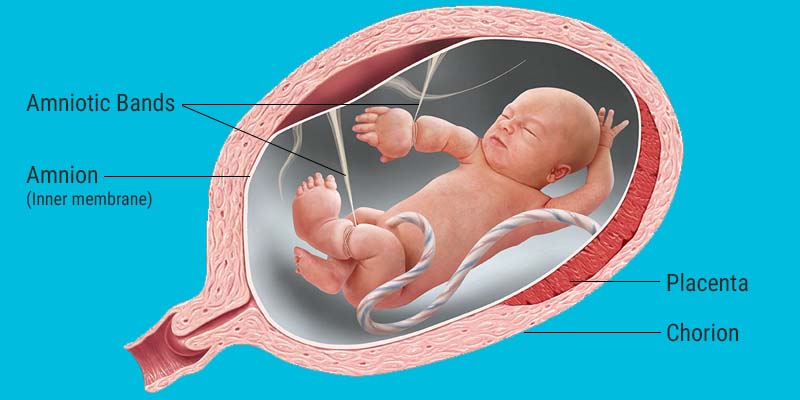During pregnancy baby develops as a fertilized egg, this egg comprises an embryo and fluid around it known as amniotic fluid forming an amniotic sac. This sac is thin but a tough membrane surrounding the baby. The main role of this sac is to ensure the safety of the embryo by acting as a shock absorbent and as a cushion to the baby. It also provides space to the forum to move around during its initial development.
What is Amniotic Band Syndrome?
It is also known as Annular Band constriction, Intrauterine amputation as well as Limb-body wall complex. Amniotic Band Syndrome is defined as a defect that occurs amnion damages in pregnancy. The damage is in the form of fibrous bands of the amniotic sac wrapping around the different parts of the baby and restricting the normal development. These fibrous bands tangle around the baby resulting in reduced blood flow which causes congenital deformity of limbs. Sometimes these fibrous bands tangle tightly and cannot be separated from the baby without amputation. Amniotic Band Syndrome is often diagnosed after birth but can be rarely detected through an ultrasound.
Is it common?
Incidence of Amniotic Band Syndrome is rare to be found, 1 in 1200 live births to 1 in 15000 live births. Male as well as a female fetus is equally affected. There is no genetic association. The majority of cases are sporadic, although cases can be seen in monozygotic twin gestation.
Causes
The following are the causes of Amniotic Band Syndrome :
Extrinsic Theory:
It is the commonest theory suggestive as a cause of Amniotic Band Syndrome. It states that the amniotic sac has an outer and inner layer. It is less likely that the inner layer gets damaged without any injury of the outer layer. Now the inner layer tear starts floating amniotic fluid and creates a life-threatening situation for the fetus as the fibrous band of the amniotic membrane gets entangled around the growing baby body.
Intrinsic Theory:
The extrinsic theory may not explain all the conditions of Amniotic Band Syndrome like a case where the amniotic sac is intact still the syndrome exists. The intrinsic theory states that poor blood flow is considered to be a cause of deformities. Here, Amniotic Band Syndrome is a result of a germ plasma defect due to certain disrupting changes at the blastogenesis stage where the soft tissue is slough off and during healing, the formation of fibrous constricting bands occurs.
There are chances the intrinsic as well as extrinsic factors are either occurring alone or combine to potentiate Amniotic Band Syndrome.
Signs and Symptoms
Amniotic Band Syndrome has different types of presentations and thus no two cases are similar. Some of the commonest patterns which occur are :
- Upper limbs and lower limbs, serious malformation
- Limb-body wall complex consisting of one or more limbs and body wall affected.
- Craniofacial abnormalities along with neural tube defects.
The following clinical features are often observed :
- Congenital constriction bands
- Syndactyly i.e. webbed digits
- Nail deformities
- Distal lymphedema
- Distal ring constrictions
- Asymmetrical limbs
- Limb amputation
- Stunted growth of small digits
- Club foot
- Protrusion of brain and meninges through skull defects
- Cleft palate with cleft lip
- Chest wall as well as abdominal wall defects
Complications
Similar to signs and symptoms, complications of Amniotic Band Syndrome varies from case to case. Some complications are:
- Fused fingers or toes
- The fibrous band entangles around the umbilical cord or head leading to the death of the fetus.
- Clubbing of feet due to restricted mobility of entangled legs in the band.
- Dissimilar limb lengths.
- Baby born along the band attached to the body
- Crease marks over the skin due to entanglement.
- Nail deformity
Diagnosis
After birth
- Soon after birth, Amniotic Band Syndrome can be diagnosed through physical findings. The least diagnostic feature is described as defects of arms, legs, fingers, and toes.
- X-ray imaging enables to identify the extent of the band inside the deep tissues and MRI scan to determine the effect on blood vessels and nerves.
Before birth
- Rarely routine ultrasound can diagnose the syndrome in women with risk factors.
- Other tests like amniocentesis where a small amount of amnion fluid is drawn out and studied, which may help in diagnosing the syndrome.
- A fetal echocardiogram may also help in the differential diagnosis of defective heart development.
Treatment
If bands are not deep and cause no symptoms or health issues to occur, then no treatment is necessary. The mainstay treatment is supportive and symptomatic.
- Clubfeet: Can be treated with casts
- Cleft Lip and Plate: Through reconstructive surgery at an early age of about 3 to 6 months.
- Webbed Fingers: After birth, hand surgery is recommended in these babies.
- Missing Limbs: For babies who lost their large part of limbs can go for Prosthetics.
During Pregnancy
- If diagnosed with Amniotic Band Syndrome, close monitoring is required. If bands cause no harm to the bay, then no intervention is required. Although if any life-threatening situation occurs, foetoscopy is advised.
During delivery
- It is better to go for a cesarean section to prevent further complications.
- There should be early delivery induction for each case of Amniotic Band Syndrome.
Conclusion
Amniotic Band Syndrome can be associated with different types of birth defects. The severity of this range from a single to multiple complications. It is caused due to intrinsic and extrinsic factors. Treatment options are available, but in serious complications, nothing can be done.
References:
https://www.ncbi.nlm.nih.gov/books/NBK545283/
